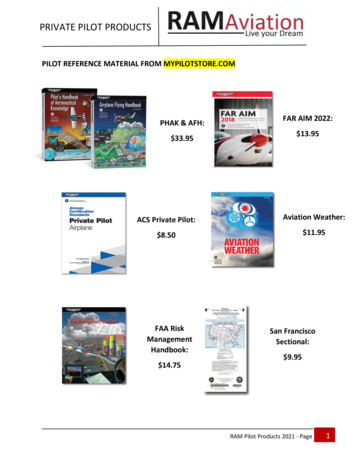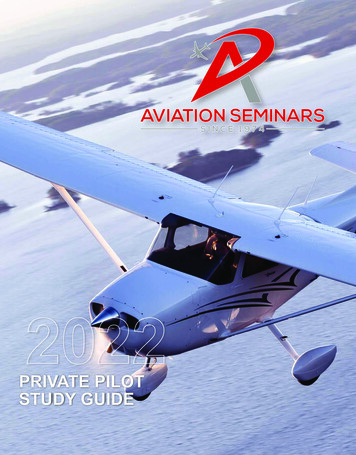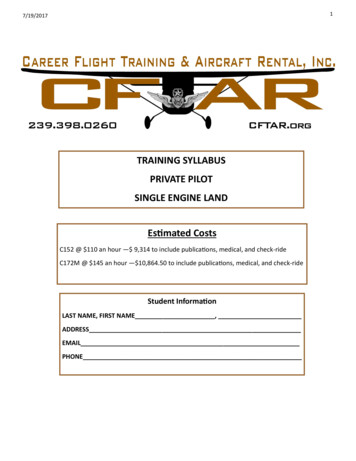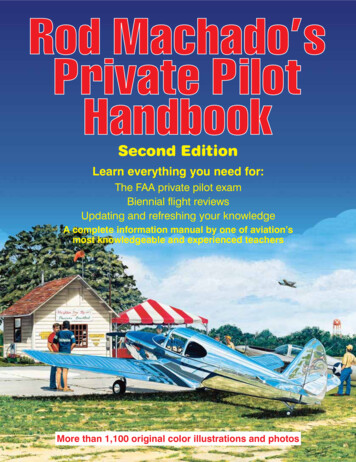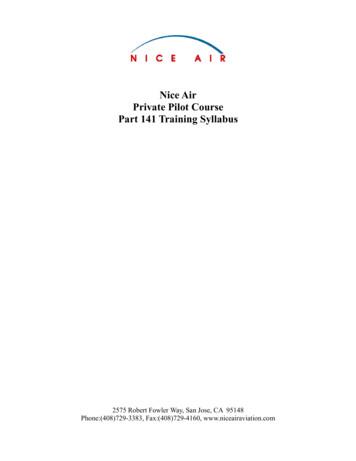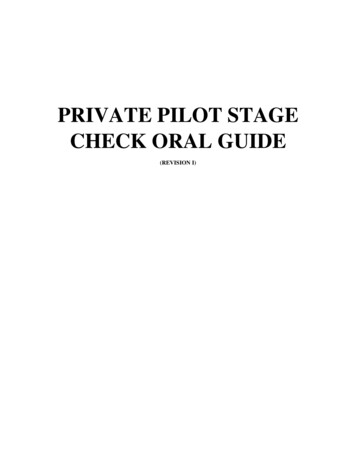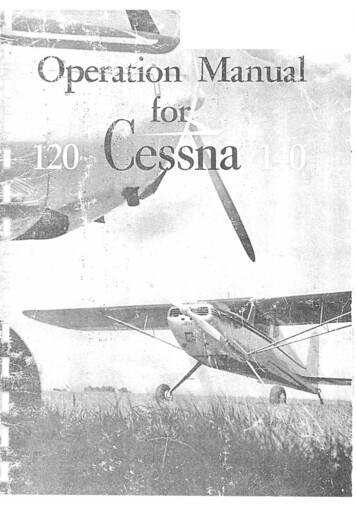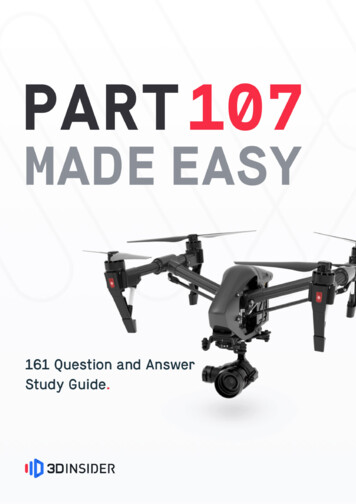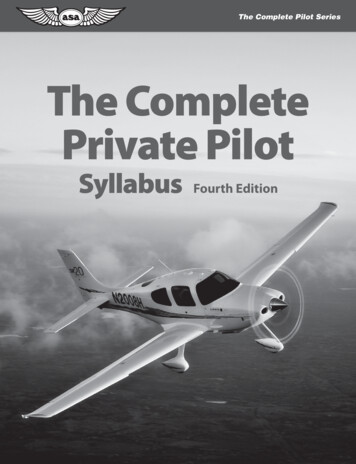
Transcription
The Complete Pilot SeriesThe CompletePrivate PilotSyllabusFourth Edition
The CompletePrivate PilotSyllabus Fourth EditionFlight and Ground TrainingPrivate Pilot Certification Course: AirplaneMeets 14 CFR Part 141 and Part 61 RequirementsIncludes Sport Pilot Certification Course: AirplaneAviation Supplies and Academics, Inc.7005 132nd Place SENewcastle, WA 98059-3153
The Complete Private Pilot SyllabusFourth Edition 1994–2011 Aviation Supplies & Academics, Inc.All rights reserved. Published 2011This syllabus is designed to be used with the textbook,The Complete Private Pilot, by Bob Gardner.Aviation Supplies & Academics, Inc.7005 132nd Place SENewcastle, Washington 98059-3153Email: asa@asa2fly.comVisit the ASA website often, as any updates due to FAA regulatoryand procedural changes will be posted there: www.asa2fly.comPrinted in the United States of America2014201320122011ASA-PPT-S4ISBN 1-56027-866-8978-1-56027-866-503iiThe Complete Private Pilot Syllabus987654321
ContentsPageStudent Information .vIntroduction .viiPrivate Pilot Course Hours . viiiStage 1: Solo Flight .1Flight Lesson 1 .2Ground Lesson 1 .3Flight Lesson 2 .4Flight Lesson 3 .6Ground Lesson 2 .8Flight Lesson 4 .9Flight Lesson 5 .11Ground Lesson 3 .12Flight Lesson 6 .13Flight Lesson 7 (Pre-Solo Exam) .14Ground Lesson 4 (Stage 1 Exam).15Flight Lesson 8 .16Solo Endorsements .17Flight Lesson 9 (Stage 1 Check) .18Stage 2: Cross-Country .19Ground Lesson 5 .20Flight Lesson 10 .21Flight Lesson 11 .23Ground Lesson 6 .24Flight Lesson 12 .25Alternate Airport Endorsement .26Flight Lesson 13 .26Ground Lesson 7 .27Flight Lesson 14 .28Flight Lesson 15 .29Ground Lesson 8 .30The Complete Private Pilot Syllabusiii
Flight Lesson 16 .31Flight Lesson 17 .32Ground Lesson 9 (Stage 2 Exam).34Flight Lesson 18 .35Cross-Country Endorsements .36Flight Lesson 19 (Stage 2 Check) .37Stage 3: Pilot Operations .39Ground Lesson 10 .40Flight Lesson 20 .41Flight Lesson 21 .42Ground Lesson 11 .43Flight Lesson 22 .43Flight Lesson 23 .44Ground Lesson 12 (Stage 3 Exam and Final Exam) .45Flight Lesson 24 (Stage 3 Check) .45Flight Lesson 25 .46Private Pilot Endorsements.47Checkride Checklist .47Pre-Solo Exam .49Stage Exams .53Stage 1 Exam .53Stage 2 Exam .65Stage 3 Exam .79Final Exam .85Maps .99Appendix . Appendix – 1Sport Pilot Addendum . Appendix – 2Answers to Exam Questions . Appendix – 5Enrollment Certificate . Appendix – 7Graduation Certificate . Appendix – 7Private Pilot Certificate Application (FAA Form 8710-1) . Appendix – 8ivThe Complete Private Pilot Syllabus
Student InformationNameAddressLast,FirstStreet(If mailing address is P.O. Box, please list herEmailEmergency ContactNamePhonePrivate Pilot course enrollmentSport Pilot course enrollmentDateEnrollment notice to FAA (Part 141)DateDateStudent Pilot/Medical Certificate: Issue DateClassPrevious SchoolTraining credit transferFlightGroundRecord of Aircraft CheckoutsDateMake/ModelInstructor SignatureRemarksRecord of Course CompletionPrivate Pilot/Sport Pilot FAA Knowledge ExaminationGraduation CertificateDateScoreDate IssuedPrivate Pilot/Sport Pilot FAA Practical TestDateResultsThe Complete Private Pilot Syllabusv
viThe Complete Private Pilot Syllabus
IntroductionThe Complete Private Pilot Syllabus is designed to work with The Complete Private Pilot (Eleventh Edition) byBob Gardner. This textbook can be used in the ground training sessions outlined in Stages 1-3. In addition, recommended readings from ASA’s Private Pilot Test Prep are given for the ground training sessions.Enrollment PrerequisitesThe student must be able to read, speak, write, and understand the English language and meet the physical standards for a third-class medical certificate prior to enrollment, and must possess a valid student pilot certificate anda third-class medical certificate (or higher) prior to completion of Flight Lesson 8, Stage 1. Students must be 16years old to solo, and 17 years old to earn a private pilot certificate.Training Course ObjectivesThe student will obtain the aeronautical skill and experience necessary to meet the requirements of a private pilotcertificate with an airplane category and single-engine land class rating, and the aeronautical knowledge necessary to pass the FAA Knowledge Exam.Course Completion StandardsThe student will demonstrate through flight tests, written tests, and school records the necessary aeronautical skill,knowledge, and experience to pass the FAA Private Pilot Knowledge Exam and obtain a private pilot certificatewith an airplane category and a single-engine land class rating. Each Task under each Area of Operation in thePrivate Pilot Practical Test Standards will have been accomplished by the student.The instructor will not sign off any Task until the student is able to explain and/or demonstrate the elements ofthe procedure or maneuver as required by the Practical Test Standards.Training SyllabusThe 35.0 hours of flight training and 35.0 hours of ground training, as required by 14 CFR Part 141 (40.0 hours offlight training and no minimum time for ground training is specified for Part 61 programs) will be accomplishedin three stages. Each of these instructional units is described in the following pages. The aeronautical experiencemust include 35.0 hours in an airplane; however, a ground training device acceptable to the Administrator ofthe Federal Aviation Administration may be substituted for 20 percent of the required time if the ground trainercomplies with 14 CFR Part 141.41(a), and may be substituted for 15 percent of the required time if the groundtrainer complies with 14 CFR Part 141.41(b). A Basic Aviation Training Device (Basic ATD) may be used for 2.5hours of the required time.Hours shown for each lesson for flight training, preflight briefing, and post-flight critique are offered as aguide to the instructor. Specified minimum times for an entire stage must be complied with, but time used for anindividual lesson may be adjusted to the student’s needs. The instructor is responsible for ensuring all requirements are met.At points where normal student progress should meet the requirements of the Practical Test Standards for aTask included in an Area of Operation, the Area of Operation and Task are listed under Completion Standards;however, it is not mandatory that the instructor sign off the Task in order for the lesson to be considered complete.The Complete Private Pilot Syllabusvii
Private Pilot Course HoursThis syllabus complies with 14 CFR Part 141 requirements. To follow a Part 61 curriculum, add 5 hours of solo flighttime, for a total of 40 hours. Part 61 requires 10 hours of solo time, including 5 hours of solo cross-country (withthe long cross-country being 150 nm).Ground instruction for Flight Lessons include preflight briefings and post-flight critiques.*14 CFR Part 141 requires 20 hours of dual flight, 5 hours of solo flight, and a total of 35 hours flight time for the Private Pilot Certificate.Those flights tagged with an asterisk (*) indicate the flights which may be conducted either Dual or Solo, at the instructor’s discretion.FlightDualFlightSoloFlightDual X/CSolo X/CDual NightSolo NightInstrument GroundInstruction InstructionStage 1Flight 11.01.0Ground 11.5Flight 21.0Flight 31.00.50.25Ground 20.51.5Flight 41.00.250.5Flight 51.00.250.5Ground 31.5Flight 61.0Flight 71.00.50.25Ground 40.5 PreSolo Exam1.5 Stage 1 ExamFlight 80.5Flight 9Stage Check1.00.50.50.250.5Stage 2Ground 51.5Flight 101.5Flight 110.50.250.50.50.5Ground 61.5Flight 121.0*0.5Flight 131.50.5Ground 71.5Flight 14Flight 15viii1.0*1.0The Complete Private Pilot Syllabus0.50.250.5
FlightDualFlightStage 2(cont.)SoloFlightDual X/CSolo X/CDual NightSolo NightInstrument GroundInstruction InstructionGround 81.5Flight 161.01.0Flight 172.02.00.252.0(includes5 TOL)1.0Ground 91.5 Stage 2ExamFlight 18Flight 19Stage Check1.02.52.5( 100 nm,3 TOL attoweredairport)1.01.01.0(includes5 TOL)0.250.5Stage 3Ground 101.5Flight 203.0*3.0*1.0Flight 214.0*4.0*1.0Ground 11Flight 221.51.5Flight 230.251.0*0.51.0Ground 121.5 Stage 3Exam Final ExamFlight 24Stage Check1.50.251.0Flight 251.50.251.0Totals20.0† 10*5.0 10*3.035.0optionaloptional40 hrs (Part 61)35 hrs (Part 141)3.02.5 3.0 † Includes 3 hours prep for checkride. Part 61 programs require 10 hours of solo flight. Including 1 X/C more than 100 nm, 3 points for Part 141 programs. Part 61 programs require5.0 hours solo X/C, with the long flight being 150 nm. Including 1 X/C of more than 100 nm and 10 takeoffs and landings (TOL).The Complete Private Pilot Syllabusix
xThe Complete Private Pilot Syllabus
Stage 1: Solo FlightFlight Training8.5 Hours Dual (1.25 Hours Instrument)0.5 Hour SoloObjectivesThe student will be instructed in all the basic flying procedures and skills necessary for the first solo flight.Completion StandardsThe Stage will be completed when the student satisfactorily passes the Stage 1 check and is able to conduct soloflights.Ground Training11.0 HoursPre-Solo ExamStage 1 ExamObjectiveIn Stage 1 the student will be introduced to a typical general aviation airplane, learn the airplane’s parts and how itis constructed. The student will learn the basics of aerodynamics, will be introduced to airplane engines and instruments, will learn how to perform weight and balance calculations, and how to use handbook information to predictaircraft performance.Completion StandardsStage 1 will be complete when the student has taken the Stage 1 written examination and has achieved a minimumpassing score of 80 percent. The instructor will discuss and resolve all incorrect answers with the student beforegoing on to Stage 2.Stage 1: Solo Flight1
Flight Lesson 1Dual 1.0 HourPre/Postflight 1.0 HourObjectivesThe student will be familiarized with the aircraft, its operating characteristics, cabin controls, instruments, systems,preflight procedures, use of checklists, and safety precautions. The student will practice climbs, straight-and-levelflight, turns, and descents.Content1. Preflight discussion2. Preflight inspectiona. Aircraft status —maintenance writeups, etc.b. Aircraft and engine logbooks, inspection statusc. External inspectiond. Servicing procedures — fuel grade, oil type and quantitye. Ground handling and safety; propeller cautionsf. Required documents—AROWg. Placards and limitation markingsh. Seat adjustment and check of locking mechanismi. Hobbs meter/tachometer entriesj. Stowage of tow bar, etc.k. All doors and hatches secured3. Introductiona. Special Emphasis Areas discussion: positive aircraft control, positive exchange of flight controls, stall/spinawareness, collision avoidance, wake turbulence avoidance, LAHSO, runway incursion avoidance, controlled flight into terrain, aeronautical decision making, checklist usageb. Starting and taxiingc. Runup; significance of items checkedd. Takeoff, pattern departure, and initial climbe. Level off; straight-and-level flight; trimf. Medium banked turnsg. Descentsh. Traffic pattern entry, approach and landingi. Radio communication; microphone usej. Climbing turns (VR and IR)(1) Left-turning tendency; torque factors(2) Relate 10 bank (IR) to natural horizon(3) Rudder use for entry and recovery from banked flight4. Fill out enrollment certificate. See Page Appendix –5.5. Postflight critique and preview of next lesson2The Complete Private Pilot Syllabus
Completion StandardsThe student will be able to maintain straight-and-level flight with a tolerance of 200 feet in altitude and 20 inheading, to perform climbs, descents, turn entries and turn recoveries with proper rudder use (1/2 ball width), andto explain proper control use for straight-and-level flight, turns, climbs, and descents. The student will understandand be able to explain pitch, bank, and airspeed limits.Date of completion Time flownInstructor signature Student initialsGround Lesson 11.5 HoursReading AssignmentThe Complete Private Pilot, Lesson 1Lesson ContentFuselage constructionAirplane componentsLift development; components of the lift equationLift, thrust, and dragAxes of rotation; center of lift vs. center of gravityControl effectsStability, longitudinal and lateralTurn dynamicsStalls and spinsDate of completion Lesson timeInstructor signature Student initialsRecommended Reading: Private Pilot Test Prep, Chapter 1Stage 1: Solo Flight3
Flight Lesson 2Dual 1.0 HourPre/Postflight 0.5 HourObjectivesThe student will review the maneuvers covered in Lesson 1. The instructor will introduce climbing turns, slow flight,power-off stalls, and steep turns, as exercises in coordination.Content1. Preflight discussion2. Starting and taxiinga. Use of checklistb. Engine start (discuss priming and flooded starts)c. Runup and pre-takeoff checklist. Student explains each action3. Takeoff and departure; initial climba. Application of power; rudder useb. Takeoff trim; elevator use and takeoff attitudec. Clearing turns while climbing4. Straight-and-level flighta. Attitude, power setting and airspeedb. Use of trimc. Speed changes in level flight5. Climbing turns (VR and IR)a. Use of attitude indicator banking scale vs. natural horizonb. Pitch and power coordination during entryc. Rudder use in left vs. right turnsd. Pitch and power coordination during recovery6. Slow flighta. Pitch and power relationshipb. Use of flaps and flap limit speedsc. Loss of visibility at high pitch attitudesd. Recovery to cruise flighte. Power curve—lift vs. drag7. Power-off stallsa. Clearing turnsb. Recovery without powerc. Recovery with powerd. Effect of flaps on indicated stall speed8. Steep turnsa. Use of elevator and powerb. Overbanking tendency9. Approach and landing10. Postflight critique and preview of next lesson4The Complete Private Pilot Syllabus
Completion StandardsThe student will be able to use checklists, start the engine, taxi, and perform the preflight runup without assistance;take off and climb at the recommended climb speed 10 knots; maintain level flight within 150 feet of altitude and 15 of heading; perform coordinated climbing turn entries and recoveries to the same tolerances; and recognizeand recover from power-off stalls with or without power.Practical Test StandardsPreflight PreparationCertificates and DocumentsAirworthiness RequirementsPreflight ProceduresPreflight InspectionCockpit ManagementPostflight ProceduresAfter Landing, Parking and SecuringDate of completion Time flownInstructor signature Student initialsStage 1: Solo Flight5
Flight Lesson 3Dual 1.0 Hour (0.25 Hour Instrument)Pre/Postflight 0.5 HourObjectivesThe student will demonstrate proficiency in the four basic maneuvers and perform, without assistance, slow flight,power-off stalls, and steep turns. The student will further explore the full regime of flight through the introduction ofslips, use of flaps, and climbs and descents with various combinations of pitch, power, airspeed, and flap extension.The student will assume pilot-in-command responsibility for preflight, taxi, and runup operation.Content1. Preflight discussion2. Review and practicea. Takeoff, departure, climb, and climbing turns (VR and IR)b. Level off and straight-and-level flight (VR and IR)c. Medium banked turns (VR and IR)d. Traffic pattern, approach and landing3. Introductiona. Slips(1) Bank angle vs. rudder pressure in cruise and slow flight(2) Sideslips and forward slips(3) Slipping as a steep approach techniqueb. Flap use (VR and IR)(1) Flap extension in slow flight at constant altitude and airspeed(2) Flap extension in slow flight at constant altitude and power(3) Flap extension in transitioning from cruise to slow flight(4) Loss of lift due to flap retraction(5) Simulated go-around from landing configurationc. Climbs and descents (VR and IR)(1) Constant airspeed climb by increasing power(2) Constant power climb with reduced airspeed(3) Constant airspeed descent by reducing power(4) Constant power descent with increasing airspeed(5) Constant rate, constant airspeed climb(6) Constant rate, constant airspeed descent(7) Power-off descent at best glide speedd. Slow flight (VR and IR)(1) Slowing to approach speed(2) Pitch and power relationship(3) Maneuvering during slow flight and the region of reversed command(4) Turn rate vs. bank angle at low airspeeds(5) Control effectiveness and feel(6) Adverse aileron drag and yaw6The Complete Private Pilot Syllabus
e. Power-off stalls (VR and IR)(1) Straight ahead —recognition and recovery(2) Turning—recognition and recovery(3) Emphasis on changing elevator deflection and pressure needed to maintain pitch attitude prior to stalland relation to landing attitudef. Approach and traffic pattern(1) Visual scanning pattern for collision avoidance(2) Speed adjustment for spacing from other traffic(3) Relation of pattern to runway and wind(4) Key position and consistency of airspeed and altitude(5) Power adjustment and flap use(6) Visual clues for beginning the flare(7) Touchdown attitude4. Postflight critique and preview of next lessonCompletion StandardsThe student will perform all maneuvers from previous lessons with tolerances of 150 feet in altitude, 15 in heading, 5 knots in airspeed with l/2-ball-width maximum deflection. Climbs, descents, and slips will be accomplishedwithin 10 knots, 200 FPM, 20 in the various configuration, with student anticipation of pitch changes and/orpressures necessary to prevent unnecessary pitch variations. The student will promptly trim off all unnecessary controlpressures, and demonstrate prompt decision-making when required.Practical Test StandardsPreflight ProceduresEngine StartingTaxiingBefore Takeoff CheckTakeoffs, Landings, and Go-AroundsNormal Takeoff and ClimbDate of completion Time flownInstructor signature Student initialsStage 1: Solo Flight7
Ground Lesson 21.5 HoursReading AssignmentThe Complete Private Pilot, Lessons 2 and 3Lesson ContentThe 4-cycle engineIgnitionInduction systemsFuel systemsMixture controlFuel grade and contaminationPreignition and detonationEngine instrumentationElectrical and vacuum systemsConstant speed propellersTurbochargingPressurizationRotax enginesPitot-static instrumentsGyroscopic instrumentsMagnetic compassDate of completion Lesson timeInstructor signature Student initialsRecommended Reading: Private Pilot Test Prep, Chapter 28The Complete Private Pilot Syllabus
Flight Lesson 4Dual 1.0 Hour (0.25 Hour Instrument)Pre/Postflight 0.5 HourObjectivesDuring this lesson the student will further explore the limits of airplane performance, with the added complexityof left-turning tendency, G-loading and various flap configurations. The student will transition naturally into thesemaneuvers from the review of previously learned maneuvers: slow flight is pursued beyond its limit into power-onstalls; steep turns and slow flight are combined to produce accelerated stalls; glides, speed changes, and flap extension are combined, as on an approach, until an approach-to-landing stall develops. This lesson will emphasize notonly recognition and recovery from stalls but also the situations which lead to inadvertent stalls. Power-off glideswill be reviewed, with engine failure emergency procedures introduced. Wind effects will be investigated throughthe introduction of crosswind/downwind taxi techniques and elementary ground reference maneuvers.Content1. Preflight discussion2. Review and practicea. Takeoff, departure, climbing turns (VR and IR)b. Level off and straight-and-level flight (VR and IR)c. Medium turns (VR and IR)d. Maneuvering during slow flight (VR and IR)e. Slips and descentsf. Traffic pattern, approach, and landing3. Introductiona. Taxiing with crosswind/tailwind(1) Control use(2) Speed control and brake use(3) Weathervaning in turnsb. Power-on stalls(1) Turning tendency(2) Rudder use(3) Control effectiveness(4) Adverse yaw(5) Rolling tendency(6) Attitude and directional control(7) Attitude and elevator force for recovery; overpowering trim if requiredc. Accelerated stalls (VR and IR)(1) G-loading vs. stall speed(2) Turning stalls(3) Secondary stallsd. Approach-to-landing stalls(1) Simulate traffic pattern(2) Straight ahead(3) Turning(4) Effect of flapsContinuedStage 1: Solo Flight9
e. Elementary forced landings(1) Best glide speed(2) Trim(3) Selection of landing site(4) Troubleshooting; restarting engine(5) Communications(6) Shut down proceduresf. Ground reference maneuvers(1) Tracking a straight line(2) Rectangular course(3) Tracking a runway—forward slip methodg. Collision avoidance(1) Outside cockpit vision(2) Scanning patterns(3) Aircraft lighting(4) Right-of-way rules4. Postflight critique and preview of next lessonCompletion StandardsSuccessful completion requires the student to perform all maneuvers from previous lessons without assistance. Thestudent will recognize and promptly recover from the newly introduced stalls, without assistance or loss of control.The student should begin anticipating and making corrections for the effect of wind on the aircraft’s ground trackand understand basic emergency procedures. Altitude, airspeed, and heading tolerances remain in force.Practical Test StandardsPreflight PreparationOperation of SystemsAirport OperationsRadio Communications and ATC Light SignalsTraffic PatternsPerformance ManeuverSteep TurnsBasic Instrument ManeuversStraight-and-Level FlightC
The Complete Private Pilot Syllabus is designed to work with The Complete Private Pilot (Eleventh Edition) by Bob Gardner. This textbook can be used in the ground training sessions outlined in Stages 1-3. In addition, recom-mended readings from ASA's Private Pilot Test Prep are given for the ground training sessions. Enrollment Prerequisites
